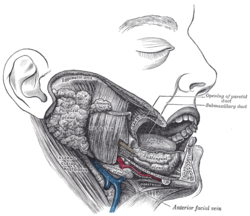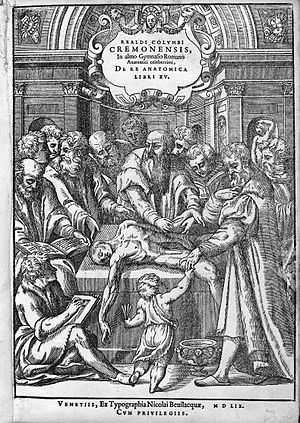- Dissection
-
This article is about the biological examination process. For other uses, see Dissection (disambiguation).
Dissection (also called anatomization) is usually the process of disassembling and observing something to determine its internal structure and as an aid to discerning the functions and relationships of its components.
In the past, anatomization of the body of a convicted person was sometimes ordered as part of the punishment. It happened in 1805 in Massachusetts to James Halligan and Dominic Daley after their public hanging. The bodies were taken to the local slaughterhouse. Their remains were denied a burial.
Contents
In biology
Dissection is usually applied to the examination of plants and animals. The term is also used in relation to mechanisms, computer programs, written materials, etc., as a synonym for terms such as reverse engineering or literary deconstruction. Dissection is usually performed by students in courses of biology, botany and anatomy and in association with medical and arts studies.
Vivisection refers to the dissection of a living animal, often for the purposes of physiological investigation and nowadays always under heavy sedation. However, the term is no longer widely used, in part because more sophisticated techniques have superseded it for many applications. The term is now almost entirely used in a pejorative sense by those who oppose animal testing of any sort.
Dissection is often performed as a part of determining a cause of death in autopsy (on humans) and necropsy (on animals) and is an intrinsic part of forensic medicine, such as would be practiced by a coroner.
History
Early systematic human dissections were carried out by the Greek physicians Herophilus of Chalcedon and Erasistratus of Chios in the early part of the third century BC.[1] Before and after this time investigators appeared to largely limit themselves to non-human animals.[2] Roman law forbade dissection and autopsy of the human body,[3] so physicians such as Galen were unable to work on cadavers. Galen for example dissected the Barbary Macaque and other primates, assuming their anatomy was basically the same as that of humans.[4][5][6]
It is not clear whether or not human dissections were also conducted by Arabic physicians. Islamic scholars such as Al-Ghazali expressed support for its practice [7] Some of the Arabic physicians who may have performed dissections include Ibn Zuhr (Avenzoar) (1091–1161) in Al-Andalus,[8][unreliable source?] Saladin's physician Ibn Jumay' during the 12th century, Abd-el-latif in Egypt circa 1200,[9] and Ibn al-Nafis in Syria and Egypt during the 13th century.[7][10][11]
Unlike pagan Rome, Christian Europe did not exercise a universal prohibition of the dissection and autopsy of the human body and such examinations were carried out regularly from at least the 13th century.[2][12][13] It has even been suggested that the Christian theology contributed significantly to the revival of human dissection and autopsy by providing a new socio-religious and cultural context in which the human cadaver was no longer seen as sacrosanct.[2]
Throughout history, the dissection of human cadavers for medical education has experienced various cycles of legalization and proscription in different countries. An edict of the 1163 Council of Tours, and an early 14th century decree of Pope Boniface VIII have mistakenly been identified as prohibiting dissection and autopsy,[14][15] but no universal prohibition of dissection or autopsy was exercised during the Middle Ages. Rather, the era witnessed the revival of an interest in medical studies, and a renewal in human dissection and autopsy.[16] Some European countries began legalizing the dissection of executed criminals for educational purposes in the late 13th and early 14th centuries, and Mondino de Liuzzi carried out the first recorded public dissection around 1315. Vesalius in the 16th century carried out numerous dissections in the process of performing some of the most extensive anatomical investigations up to his time, but was attacked frequently by other physicians for his disagreement with Galen's studies of human anatomy. For many years it was assumed that Vesalius's pilgrimage to Palestine was an escape from pressures of the Inquisition brought as a result of his work with cadavers. Today this is generally considered to be without foundation (see C.D. O'Malley Andreas Vesalius' Pilgrimage, Isis 45:2, 1954) and is dismissed by modern biographers.
In England, dissection remained entirely prohibited until the 16th century, when a series of royal edicts gave specific groups of physicians and surgeons some limited rights to dissect cadavers. The permission was quite limited: by the mid 18th century, the Royal College of Physicians and Company of Barber-Surgeons were the only two groups permitted to carry out dissections, and had an annual quota of ten cadavers between them. As a result of pressure from anatomists, especially in the rapidly growing medical schools, the Murder Act 1752 allowed the bodies of executed murderers to be dissected for anatomical research and education. By the 19th century this supply of cadavers proved insufficient, however, due to both the continuing expansion of medical schools, and the creation of a number of private medical schools, which lacked legal access to cadavers. A thriving black market arose in cadavers and body parts, leading to the creation of an entire profession of body-snatcher, and even more extremely, the infamous 1827 and 1828 Burke and Hare murders, in which 17 people were murdered in order to sell their cadavers to anatomists. The resulting public outcry largely led to the passage of the Anatomy Act 1832, which greatly increased the legal supply of cadavers for dissection. (See also: History of anatomy in the 19th century.)[17]
By the 21st century, the availability of interactive computer programs and changing public sentiment led to renewed debate on the use of cadavers in medical education. The Peninsula College of Medicine and Dentistry in the UK, founded in 2000, became the first modern medical school to carry out its anatomy education without dissection, though most medical schools continue to see experience with actual cadavers as preferable to entirely computer-based education.[18]
Dissections of non-human animals have also been used for educational purposes, often in general science education where the use of human cadavers would not be justified. In the U.S., dissection of frogs became common in college biology classes from the 1920s, and gradually began to be introduced at earlier stages of education. By 1988, an estimated 75–80% of American high school biology students were participating in a frog dissection, with a trend towards introduction in elementary schools. The dissected frogs are most commonly from the Rana genus. Other popular animals for high-school dissection at the time of that survey were, among vertebrates, fetal pigs, perch, and cats; and among invertebrates, earthworms, grasshoppers, crayfish, and starfish.[19]
Controversy over dissection in U.S. high schools became prominent in 1987, when a California student, Jenifer Graham, sued to require her school to let her complete an alternate project. The court ruled that mandatory dissections were permissible, but that Graham could ask to dissect a frog that had died of natural causes rather than one that was killed for the purposes of dissection; the practical impossibility of procuring a frog that had died of natural causes in effect let Graham opt out of the required dissection. The suit also gave considerable publicity to anti-dissection advocates: Graham appeared in a 1987 Apple Computer commercial for the virtual-dissection software Operation Frog.[20][21] The state of California passed a Student's Rights Bill in 1988 requiring that objecting students be allowed to complete alternative projects.[22] The trend towards students opting out of dissection increased through the 1990s.[23]
Tools used
The following are tools commonly used in biological dissection.
- Scalpel
- Scissors (dissecting scissors)
- Thumb Forceps or Fine point splinter
- Mall probe and seeker
- Surgical Spatula
- Magnifying glass
- Chain & Hooks (surgical)
- Razor
- Blow Pipe (surgical)
- Prong (surgical)
- Teasing needles
- Pipette or Medicine dropper
- Ruler or caliper
- T pins
- Dissecting Pan
Additional images
References
- ^ The discovery of the body: human dissection and it...[Yale J Biol Med. 1992 May-Jun] - PubMed Result
- ^ a b c P Prioreschi, Determinants of the revival of dissection of the human body in the Middle Ages', Medical Hypotheses (2001) 56(2), 229–234)
- ^ 'Tragically, the prohibition of human dissection by Rome in 150 BC arrested this progress and few of their findings survived', Arthur Aufderheide, 'The Scientific Study of Mummies' (2003), page 5
- ^ Vivian Nutton, 'The Unknown Galen', (2002), page 89
- ^ Heinrich Von Staden, 'Herophilus' (1989), page 140
- ^ Philip Lutgendorf, 'Hanuman's Tale: The Messages of a Divine Monkey' (2007), page 348
- ^ a b Savage-Smith, Emilie (1995). "Attitudes toward dissection in medieval Islam". Journal of the History of Medicine and Allied Sciences 50 (1): 67–110. doi:10.1093/jhmas/50.1.67. PMID 7876530
- ^ Islamic medicine, Hutchinson Encyclopedia.
- ^ Emilie Savage-Smith (1996), "Medicine", in Roshdi Rashed, ed., Encyclopedia of the History of Arabic Science, Vol. 3, p. 903-962 [951-952]. Routledge, London and New York.
- ^ Al-Dabbagh S. A. (1978). "Ibn Al-Nafis and the pulmonary circulation". The Lancet 1: 1148.
- ^ Reflections Chairman's (2004). "Traditional Medicine Among Gulf Arabs, Part II: Blood-letting". Heart Views 5 (2): 74–85 [80].
- ^ 'In the 13th century, the realisation that human anatomy could only be taught by dissection of the human body resulted in its legalisation in several European countries between 1283 and 1365', Philip Cheung 'Public Trust in Medical Research?.', (2007), page 36
- ^ 'Indeed, very early in the thirteenth century, a religious official, namely, Pope Innocent III (1198-1216), ordered the postmortem autopsy of a person whose death was suspicious', Toby Huff, 'The Rise Of Modern Science' (2003), page 195
- ^ 'While during this period the Church did not forbid human dissections in general, certain edicts were directed at specific practices. These included the Ecclesia Abhorret a Sanguine in 1163 by the Council of Tours and Pope Boniface VIII's command to terminate the practice of dismemberment of slain crusaders' bodies and boiling the parts to enable defleshing for return of their bones. Such proclamations were commonly misunderstood as a ban on all dissection of either living persons or cadavers (Rogers & Waldron, 1986), and progress in anatomical knowledge by human dissection did not thrive in that intellectual climate', Arthur Aufderheide, 'The Scientific Study of Mummies' (2003), page 5
- ^ 'It must be noted, however, that the pope did not forbid anatomical dissections but only the dissections performed with the purpose of preserving the bodies for distant burial', P Prioreschi, Determinants of the revival of dissection of the human body in the Middle Ages', Medical Hypotheses (2001) 56(2), 229–234)
- ^ 'Current scholarship reveals that Europeans had considerable knowledge of human anatomy, not just that based on Galen and his animal dissections. For the Europeans had performed significant numbers of human dissections, especially postmortem autopsies during this era', 'Many of the autopsies were conducted to determine whether or not the deceased had died of natural causes (disease) or whether there had been foul play, poisoning, or physical assault. Indeed, very early in the thirteenth century, a religious official, namely, Pope Innocent III (1198-1216), ordered the postmortem autopsy of a person whose death was suspicious', Toby Huff, 'The Rise Of Modern Science' (2003), page 195
- ^ Cheung, pp. 37–44
- ^ Cheung, pp. 33, 35
- ^ F. Barbara Orlans, Tom L. Beauchamp, Rebecca Dresser, David B. Morton, and John P. Gluck (1998). The Human Use of Animals. Oxford University Press. pp. 213. ISBN 0195119088.
- ^ Howard Rosenberg: Apple Computer's 'Frog' Ad Is Taken Off the Air. LA Times, November 10, 1987.
- ^ F. Barbara Orlans, Tom L. Beauchamp, Rebecca Dresser, David B. Morton, and John P. Gluck (1998). The Human Use of Animals. Oxford University Press. pp. 210. ISBN 0195119088. http://books.google.com/?id=yBWL1t2b_w0C&pg=PA210.
- ^ Orlans et al., pp. 209–211
- ^ Johnson, Dirk (May 29, 1997). "Frogs' Best Friends: Students Who Won't Dissect Them". The New York Times. http://query.nytimes.com/gst/fullpage.html?res=9D00E5DF123AF93AA15756C0A961958260. Retrieved May 1, 2010.
External links
Categories:- Biological techniques and tools
Wikimedia Foundation. 2010.







